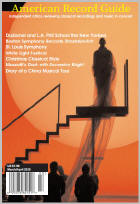Texte paru dans: / Appeared in: Château de Versailles |
|
|
Outil de traduction ~ (Très approximatif) |
|
|
Reviewer: William
J. Gatens This is music that Bach presented for his first Christmas at Leipzig in 1723. The exuberant Cantata 63 (Christen, Atzet Diesen Tag) was written in 1713 for the court chapel in Weimar. The fact that Bach used a ten-year-old cantata on this important occasion is an indication of his high regard for it. The Magnificat in E-flat, on the other hand, was a new work for the occasion, performed at Vespers on Christmas Day. In addition to the Latin Magnificat text, the work contains four Christmas inserts in keeping with Leipzig custom. Bach later revised the work as the more familiar Magnificat in D, omitting the Christmas insertions. For me, the most delicious moment of the earlier version comes in the alto aria ‘Esurientes’. It is in the key of F, which is perfect for the pair of obbligato recorders that accompany the vocal soloist. The revision puts this aria into E major with the obbligato given to transverse flutes. They are beautiful, to be sure, but they do not have the same pastoral flavor as the recorders.
This is a concert recording made in December of 2018 at the Royal Chapel in the Palace of Versailles. Admirers of early-music singers will recognize many or all of the soloists as among the finest exponents of their art. Their performances are uniformly excellent, as is the recording balance. (Often I find myself straining to hear overbalanced singers trying to cut through the instrumental accompaniment.) Choral movements are sung by four or five singers to Valentin Tournet (b 1996) is one of the more precocious early music specialists currently
active. He began playing the
viola da gamba at the age of 5 and sang in the children’s chorus of the
Paris Opera. Among his teachers are Christophe Coin, Philippe Pierlot, and
Jordi Savall. He founded the choir and period instrument ensemble La
Chapelle Harmonique in 2017. Their first major project was a concert
performance at Versailles of the second (1725) version of Bach’s St John
Passion. This is their first commercial recording. The technical standard
here is first rate. Fast tempos are very fast, but both the singers and
players have the chops to bring it off. Even the intricate-textured choruses
are as clear as can be. In most instances the rapid tempos convincingly
sweep all before them. One exception is the tenor aria ‘Deposuit’ from the
Magnificat. Thomas Hobbs makes
every
detail audible with dazzling virtuosity, but somehow the blistering tempo
detracts from the sheer power of the movement. The mighty should not be so
easily overthrown. | |
|
|
|
|
Cliquez l'un ou l'autre
bouton pour découvrir bien d'autres critiques de CD |
|




